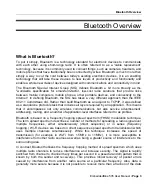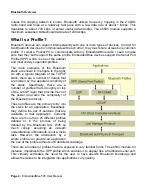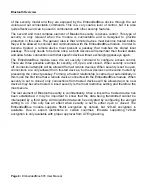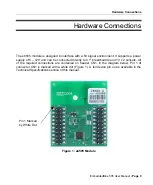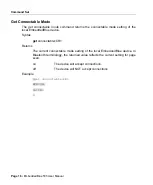
Bluetooth Overview
Bluetooth Overview
What is Bluetooth?
To put it simply, Bluetooth is a technology standard for electronic devices to communicate
with each other using short-range radio. It is often referred to as a “cable replacement”
technology, because it is commonly used to connect things, such as cameras, headsets, and
mobile phones that have traditionally been connected by wires. Bluetooth is much more than
simply a way to cut the cord between today’s existing electronic devices. It is an enabling
technology that will take these devices to new levels of productivity and functionality and
enable a whole new class of devices designed with communications and connectivity in mind.
The Bluetooth Special Interest Group (SIG) defines Bluetooth a bit more broadly as the
"worldwide specification for small-form-factor, low-cost radio solutions that provide links
between mobile computers, mobile phones, other portable devices, and connectivity to the
Internet." In defining Bluetooth, the SIG has taken a very different approach than the IEEE
802.11 Committees did. Rather than build Bluetooth as an adjunct to TCP/IP, it was defined
as a standalone protocol stack that includes all layers required by an application. This means
that it encompasses not only wireless communications but also service advertisement,
addressing, routing, and a number of application-level interfaces referred to as profiles.
Bluetooth is based on a frequency hopping spread spectrum (FHSS) modulation technique.
The term spread spectrum describes a number of methods for spreading a radio signal over
multiple frequencies, either simultaneously (direct sequence) or in series (frequency
hopping.) Wi-Fi devices are based on direct sequence spread spectrum transmission which
uses multiple channels simultaneously. While this technique increases the speed of
transmission (for example in Wi-Fi from 1.5MHz to 11MHz), it is more susceptible to
interference from other radio sources as well as being a greater source of interference to the
surrounding area.
In contrast, Bluetooth utilizes the frequency hopping method of spread spectrum which uses
multiple radio channels to reduce interference and increase security. The signal is rapidly
switched from channel to channel many times per second in a pseudo-random pattern that is
known by both the sender and receiver(s). This provides robust recovery of packet errors
caused by interference from another radio source at a particular frequency. Also, data is
generally more secure because it is not possible to receive more than a fraction of the data
EmbeddedBlue 505 User Manual
▪
Page 3
Содержание EmbeddedBlue 505
Страница 1: ...EmbeddedBlue 505 User Manual...
Страница 16: ...Hardware Connections This page intentionally left blank Page 10 EmbeddedBlue 505 User Manual...
Страница 52: ...Error Codes This page intentionally left blank Page 46 EmbeddedBlue 505 User Manual...
Страница 56: ...Technical Specifications This page intentionally left blank Page 50 EmbeddedBlue 505 User Manual...









